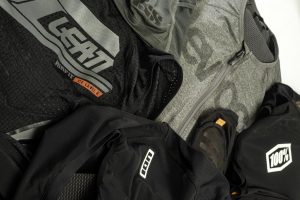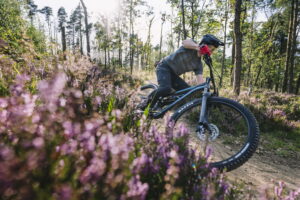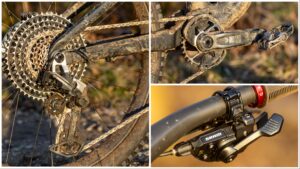A quirky tyre with a minimal tread but reinforced casing and sticky rubber for drifting DH and bike park turns.
Vee Flow R-CP tyre review
This semi-slick forms part of a subset of MTB tyres targeting fast rolling in drier conditions. Rear-specific, other options include Schwalbe’s Rock Razor and Maxxis’s Minion SS, which, like Vee’s R-CP, use a low-profile rolling strip with more pronounced shoulder knobs for cornering bite.
Such tyres tend to exhibit a distinct ‘slip to grip’ character that can be a lot of fun as it adds dynamism to turns as the contact patch transitions across the relatively less grippy middle before ‘hooking’ on edge blocks and finding traction. This lively sensation is amplified even further in damp conditions where braking traction is also reduced.

As a rear tyre the Flow R-CP lacks the pace advantage of most semi-slick designs, but does run faster than a pure DH rear tyre.
In the R-CP’s case, a lack of deep central tread blocks doesn’t mean insufficient toughness, as it was originally designed for Propain’s World Cup downhillers to roll faster on dry tracks or rip up bike parks. The single ply ‘enduro core’ casing uses reinforced 72tpi fabric with extra ‘Apex’ puncture protection, which, like the Flow Snap, is actually a fair bit thicker and tougher than rival single ply tyres. The weight’s a chunk higher too, but we’ve enjoyed zero punctures or damage after a lot of use.
The Fast 50 rubber compound relates to a 50a durometer or hardness that’s still pretty sticky compared to standard dual compound blends. The compound delivers excellent grip and stability, and decent braking traction, considering how minimal the zig zag central tread is. It even seems pretty controlled everywhere with less slip-to-grip than other semi-slicks like the Rock Razor.
This is likely because that tyre blows up more roundly on a 30mm rim, so you actually roll fast on the central belt, whereas Vee’s version is more squared-off. And, with blocks upright, rather than jutting out, this combines with the softer compound and slows rolling speed. This inflated shape took multiple pumping up and installation hassles too.
Verdict
Vee’s aggressive tyres seem extremely good at dulling and sticking, but not so good at rolling and dynamically bouncing along, which boosts control rather than speed and partially negates the benefit of the semi-slick design – basically, it starts to lose the benefits and quirks of its unique properties when it doesn’t roll much faster than an equivalent fully treaded option.
















